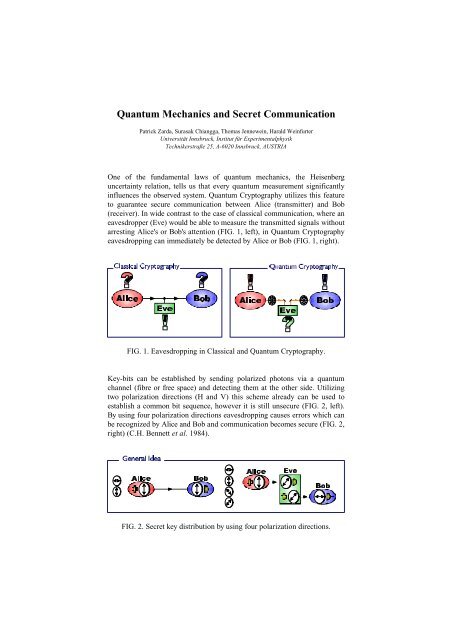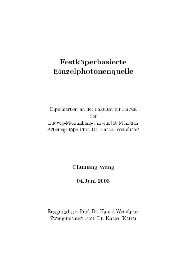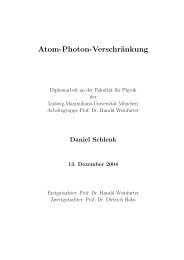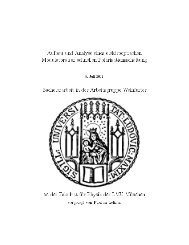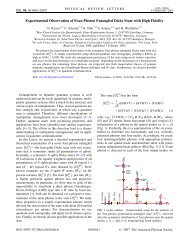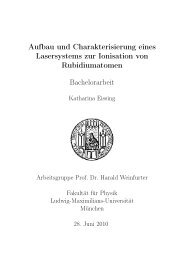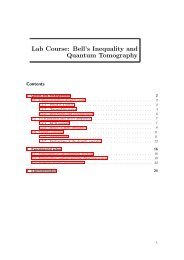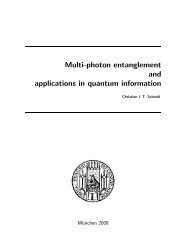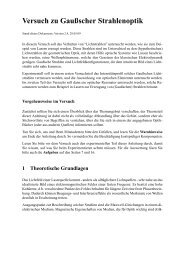Quantum Mechanics and Secret Communication
Quantum Mechanics and Secret Communication
Quantum Mechanics and Secret Communication
You also want an ePaper? Increase the reach of your titles
YUMPU automatically turns print PDFs into web optimized ePapers that Google loves.
<strong>Quantum</strong> <strong>Mechanics</strong> <strong>and</strong> <strong>Secret</strong> <strong>Communication</strong><br />
Patrick Zarda, Surasak Chiangga, Thomas Jennewein, Harald Weinfurter<br />
Universität Innsbruck, Institut für Experimentalphysik<br />
Technikerstraße 25, A-6020 Innsbruck, AUSTRIA<br />
One of the fundamental laws of quantum mechanics, the Heisenberg<br />
uncertainty relation, tells us that every quantum measurement significantly<br />
influences the observed system. <strong>Quantum</strong> Cryptography utilizes this feature<br />
to guarantee secure communication between Alice (transmitter) <strong>and</strong> Bob<br />
(receiver). In wide contrast to the case of classical communication, where an<br />
eavesdropper (Eve) would be able to measure the transmitted signals without<br />
arresting Alice's or Bob's attention (FIG. 1, left), in <strong>Quantum</strong> Cryptography<br />
eavesdropping can immediately be detected by Alice or Bob (FIG. 1, right).<br />
FIG. 1. Eavesdropping in Classical <strong>and</strong> <strong>Quantum</strong> Cryptography.<br />
Key-bits can be established by sending polarized photons via a quantum<br />
channel (fibre or free space) <strong>and</strong> detecting them at the other side. Utilizing<br />
two polarization directions (H <strong>and</strong> V) this scheme already can be used to<br />
establish a common bit sequence, however it is still unsecure (FIG. 2, left).<br />
By using four polarization directions eavesdropping causes errors which can<br />
be recognized by Alice <strong>and</strong> Bob <strong>and</strong> communication becomes secure (FIG. 2,<br />
right) (C.H. Bennett et al. 1984).<br />
FIG. 2. <strong>Secret</strong> key distribution by using four polarization directions.
The key distribution requires several steps. Alice sends photons with one of<br />
four polarizations, which she has chosen at r<strong>and</strong>om. For each photon, Bob<br />
chooses at r<strong>and</strong>om the type of measurement: either the rectilinear type (H<br />
<strong>and</strong> V) or the diagonal type (+45° <strong>and</strong> -45°). Bob records the result of his<br />
measurement but<br />
FIG. 3. Setup of our <strong>Quantum</strong> Cryptography Experiment.
keeps it secret. Bob publicly announces the type of measurement he made,<br />
<strong>and</strong> Alice tells him which measurements were of the correct type. Alice <strong>and</strong><br />
Bob keep all cases in which Bob measured the correct type. These cases are<br />
then translated into bits (1's <strong>and</strong> 0's) <strong>and</strong> thereby become the key.<br />
(C.H. Bennett et al. 1992, p. 31)<br />
Up to now a couple of <strong>Quantum</strong> Cryptography experiments were realized.<br />
Disadvantages were low bit rates in the Hz-range, large setups on optical<br />
tables or complex alignment <strong>and</strong> management. As a significant difference to<br />
other experiments we do not use active components to set or to analyze the<br />
four polarization directions. Four laser diodes aligned for the various<br />
polarizations (LD/H, LD/V, LD/+45° <strong>and</strong> LD/-45°) are switched r<strong>and</strong>omly<br />
<strong>and</strong> st<strong>and</strong>ard beam splitters are used to combine the different beams (FIG.<br />
3). On Bob's side, we use a 50%/50%-beamsplitter to direct the incoming<br />
photon either to an analyzer oriented along H/V or to another one oriented<br />
along +45°/-45°. The r<strong>and</strong>omness inherent in quantum mechanics of<br />
whether the photon is transmitted or reflected replaces thus any additional,<br />
classical r<strong>and</strong>om number generator. Synchronization of transmitter <strong>and</strong><br />
receiver is achieved also over the quantum channel by sending bright<br />
circular porarized pulses (LD/S, 20kHz) every 100 th weak pulse. The bright<br />
pulses cause 4-fold-coincidences on Bob's side where then the original<br />
2MHz-Signal can be reconstructed.<br />
Our measurements show that this compact setup is capable for a fast (pulse<br />
rate 2 MHz, effective bit rate kHz-range) <strong>and</strong> user-friendly <strong>Quantum</strong><br />
Cryptography key exchange.<br />
Work supported by the Austrian Science Foundation Y-48-PHY.<br />
Correspondence <strong>and</strong> requests to Patrick Zarda. e-mail:<br />
patrick.zarda@uibk.ac.at<br />
C.H. Bennett, <strong>and</strong> G. Brassard, "An update on quantum cryptography", in:<br />
Advances in Cryptology: Proceedings of Crypto 84, Springer-Verlag,<br />
August 1984, pp. 475 - 480.<br />
C.H. Bennett, G. Brassard, <strong>and</strong> A.K. Ekert, "<strong>Quantum</strong> Cryptography", in:<br />
Scientific American, October 1992, pp. 26-33.


